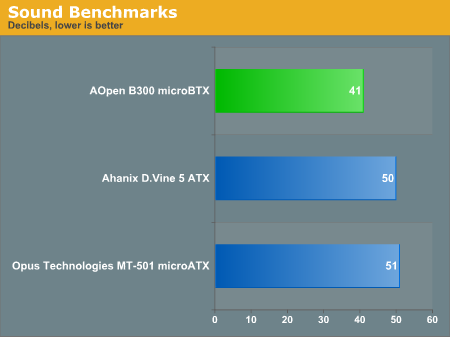Intel's Long Awaited BTX Form Factor
by Purav Sanghani on November 15, 2004 5:31 AM EST- Posted in
- Cases/Cooling/PSUs
Noise Testing ATX, BTX
Besides the thermal advantages Intel claims BTX to have over ATX, Intel also states that BTX systems will produce much lower sound levels then ATX systems. We can see this as being true since our BTX evaluation kit includes the AOpen B300 which has zero case fans. The only cooling equipment in this BTX system is the thermal module which adjusts its speed according to the overall temperature of the system and the power supply. In turn, the only hardware producing any sound in the system would be the thermal module and the power supply.As we measured the sound levels of the AOpen B300, we noticed that as the Pentium 550's temperature rose from 62 to 63 degrees, the fan speed increased from 1400rpm to 1700 rpm. We realized that the heat sink fan was overcompensating for the increase of 1 degree to bring the temperature back down to a stable level.

We see that the uBTX AOpen B300 combined with Intel's thermal module and FSP power supply produced an extremely quiet 41dB of sound compared to the ATX D.Vine 5 and uATX TT-501. The D.Vine 5 had dual 60mm fans at the back while the TT-501 actually had two 80mm fans at its rear that produced the extra 9-10dB along with the CPU heatsink fans and power supplies.
The low sound levels of the BTX system came at a price of slightly higher temperatures through the case. Is the point of BTX to eliminate case fans entirely or just reduce them to keep a positive balance between thermal and sound levels? If a 80mm or even a 60mm fan is placed at the back of the chassis directly in line with the CPU thermal module, the air flow will be increased having a greater cooling effect on the components while still keeping sound levels to a minimum.










77 Comments
View All Comments
ThelvynD - Monday, November 15, 2004 - link
We've been getting in new HP 7100s here at my work center and they've been in the micro-BTX format. I don't any major problems with it so far. Pic below.http://www.picsplace.to/044712/HP-BTX.JPG
Nonsense - Monday, November 15, 2004 - link
#36 - Thanks Purav.Can you tell me - is the PS blowing in or out, and is the CPU fan blowing in or out? I'm still trying to figure where all the air is comming from.
PuravSanghani - Monday, November 15, 2004 - link
#34: If you look at the picture of the backside of the B300 on page 8 there are groups of holes above the VGA expansion slot as well as to the right between the expansion slot and the power supply. There are also holes lining the bottom of the case if you look closely. We were surprised ourselves to find how well passively cooling all of the components in a system would actually work. And from the pictures you can also see there aren't too many holes for a large amount of air to come in through!PuravSanghani - Monday, November 15, 2004 - link
#25: Actually, the front panel connectors *are* standardized and combined into one single plug. We mentioned this on page 8 of the article, "First Look: AOpen B300 BTX case cont'd", in the paragraph where we talk about the auxiliary module.Nonsense - Monday, November 15, 2004 - link
#28 - I don't understand the air flow.If the CPU fan is blowing out the front of the case, then the PS _must_ be blowing in.
Blowing hot air into a case does not sound good. Is that how it works?
If the PS is also blowing out, then you have a vacuum. I do not see any heat comming into the case from the PS, so it must be blowing out...?!
Where is the air comming from that is cooling the graphics card? It looks like mostly dead air in that corner - there are only tiny grills on the back.
Sunbird - Monday, November 15, 2004 - link
From last paragraph of article:"The ATX case used more space and ran louder."
Space is not evil!, its a good thing for when your drop a small screw, or have hands that fit your 6'6" frame. And loudness can be adressed in other just as succesfull ways.
"Don't forget that additional non-redundant fans increase the failure rate of a computer as well - more moving parts."
And what if the single fan on the BTX sollution fails? That is really non-reduntant if you ask me, anyone agree?
Sunbird - Monday, November 15, 2004 - link
#20, I agree, I have a Packard Bell P1 133MHz flat desktop case PC in my workshop and that is almost exactly the same design as this, except the stuff like the optical drive, hard drives and power supply was swapped from the right to the left side of the case, othewise its exactly the same. Glad to see some oldschool designs again, lol#27's idea is brilliant, they quickly implemented something like that with the cases and their front USB options, those LED and power button connector have been around much longer. What's taking them so long?
epiv - Monday, November 15, 2004 - link
skunkbuster - Monday, November 15, 2004 - link
flash in the pants?Zebo - Monday, November 15, 2004 - link
This is going nowhere quick. It's obvious Intel will no longer need it when they make the Dothan desktop transition plus AMD all case and PS manufactures hate the idea. Just wahtever you do don't go buying an $300 Lian Li and $120 PSU since BTX is a flash in the pants.